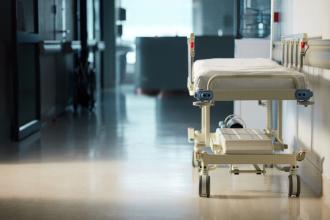Implementing saline gargle sample collection for COVID-19 testing
British Columbia was one of the first jurisdictions in the world to implement a saline rinse-gargle (“saline gargle”) collection method for COVID-19 testing. In September 2020, collection centres across BC started offering saline gargle as an alternative to nasopharyngeal (NP) swab for school-aged children and youth. By the time this article is published, saline gargle may be available to additional populations.
Why is an alternative to NP swabs needed?
As COVID-19 swept across the world in March and April, global supply chains faltered. During a pandemic, testing is critical, yet NP swabs had few suppliers and significant worldwide demand. This resulted in a global shortage of NP swabs, including in BC. The ability to test hinged on the ability to obtain NP swabs.
At the same time, tree planters from across Canada were heading to remote communities to start the planting season. This led to significant concerns regarding the spread of COVID-19 to these remote communities if symptomatic tree planters had to leave camp to seek health care services for COVID-19 testing. The ideal solution would be to allow planters to collect a specimen at their camp without a health care practitioner. NP swabs did not meet this collection criterion.
Why saline gargle?
Saliva was the most common swab-independent alternative at the time; however, some patients struggle to provide an adequate volume, and saliva is a difficult specimen type for laboratories to handle. Also, the mucoid nature of saliva was not ideal for the laboratory and required additional processing steps for the sample to be polymerase chain reaction (PCR) ready.
However, in available literature, there were limited and vague reports of using mouthwash samples for testing other viruses. Over extensive literature reviews, brainstorming, and discussions, saline gargle evolved to be a highly possible swab-independent option. Laboratory testing of PCR performance, stability, and appropriateness of the saline gargle was evaluated. Saline gargle performed well compared to the standard nasopharyngeal swab and viral transport media system.
Following the analytical validation of the sample type, a clinical validation was led by BC Children’s Hospital, which required volunteers to provide matched NP swabs, saline gargle, and saliva specimens for parallel testing. The clinical validation demonstrated that interpretation of nucleic acid test results were equivalent for the NP swab and saline gargle, while saliva was shown to have lower clinical sensitivity, particularly for pediatric patients.
As part of the clinical validation findings, participants ranked saline gargle collection as the preferred collection method, adding to the rationale for selecting it as a testing option.
A collaborative province-wide cross-validation study involving all COVID-19 testing laboratories across the province confirmed that saline gargle specimens were compatible with all COVID-19 nucleic acid-based testing platforms present in BC.
Saline gargle implementation for back-to-school
Completion of the clinical validation coincided with back-to-school planning in August, which was timely because returning to in-person schooling meant an increased number of children would require COVID-19 tests. Testing by collecting an NP swab can be traumatic for children, parents, and health care workers, but using the less-invasive saline gargle helps to lessen barriers to testing.
Provincial Laboratory Medicine Services recommended the adoption of saline gargle for school-aged children and youth across BC, and provincial implementation started on 17 September, 1 week after children returned to the classroom.
A multidisciplinary group of health care professionals spearheaded the implementation. Representatives from laboratories, BC Children’s Hospital, BCCDC, public health, COVID collection centres, and PHSA Supply Chain played critical roles in ensuring a successful launch. The group created written collection instructions and an accompanying collection video, updated guidance documents, trained front-line staff, and sourced supplies.
Testing tip
Prior to saline gargle testing, it’s critical to practise how to gargle at home with a solution of salt and water. This is especially important for young children who, initially, often immediately spat out the saline solution because of its saltiness. This required either waiting 2 hours before trying the saline gargle again or using an NP swab as the alternative.
Lessons learned
Testing continues to be key to addressing the COVID-19 pandemic, and saline gargle improves testing accessibility. This popular collection method, with high user acceptance, addresses an important aspect of the pandemic response as reluctance toward the NP swab is a barrier to testing.
The ability to increase testing among school-aged children and youth helped lessen the chance of a school-based outbreak in the first month after school started. While COVID-19 continues to circulate in the community and school-based outbreaks will occur, expanding saline gargle and increasing laboratory capacity will help BC manage the pandemic.
Multiple jurisdictions, in Canada and abroad, have taken the work performed in BC to facilitate the adoption of the saline gargle method in their region.
—Meghan McLennan, BSc, MLT
Project Manager, Provincial Laboratory Medicine Services
—David Goldfarb, MD, FRCPC
Medical Microbiologist and Pediatric Infectious Disease Physician, Associate Head, Department of Pathology and Laboratory Medicine, BC Children’s & Women’s Hospitals
—Michael Donoghue
Senior Project Manager, UBC Centre for Disease Control
—Linda Hoang, MD, DTM&H, FRCPC
Medical Microbiologist and Associate Director, BCCDC Public Health Laboratory
hidden
This article is the opinion of the BC Centre for Disease Control and has not been peer reviewed by the BCMJ Editorial Board.



Will a non-secretor patient produce a false negative COVID-19 result from a saline gargle specimen?